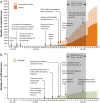Anxiety levels, precautionary behaviours and public perceptions during the early phase of the COVID-19 outbreak in China: a population-based cross-sectional survey
- PMID: 33033099
- PMCID: PMC7545627
- DOI: 10.1136/bmjopen-2020-040910
Anxiety levels, precautionary behaviours and public perceptions during the early phase of the COVID-19 outbreak in China: a population-based cross-sectional survey
Abstract
Objective: To investigate psychological and behavioural responses to COVID-19 among the Chinese general population.
Design, setting and participants: We conducted a population-based mobile phone survey between 1 February and 10 February 2020 via random digit dialling. A total of 1011 adult residents in Wuhan (n=510), the epicentre and quarantined city, and Shanghai (n=501) were interviewed. Proportional quota sampling and poststratification weighting were used. Multivariable logistic regression models were used to investigate perception factors associated with the public responses.
Primary outcome measures: We measured anxiety levels using the 7-item Generalised Anxiety Disorder Scale (GAD-7) and asked respondents to report their precautionary behaviours before and during the outbreak.
Results: The prevalence of moderate or severe anxiety was significantly higher (p<0.001) in Wuhan (32.8%) than Shanghai (20.5%). Around 79.6%-88.2% residents reported always wearing a face mask when they went out and washing hands immediately when they returned home, with no discernible difference across cities. Only 35.5%-37.0% of residents reported a handwashing duration above 40 s as recommended by the WHO. The strongest predictor of moderate or severe anxiety was perceived harm of the disease (OR 1.8, 95% CI 1.5 to 2.1), followed by confusion about information reliability (OR 1.7, 95% CI 1.5 to 1.9). None of the examined perception factors were associated with odds of handwashing duration above 40 s.
Conclusions: Prevalence of moderate or severe anxiety and strict personal precautionary behaviours was generally high, regardless of the quarantine status. Our results support efforts for handwashing education programmes with a focus on hygiene procedures in China and timely dissemination of reliable information.
Keywords: health policy; mental health; public health.
© Author(s) (or their employer(s)) 2020. Re-use permitted under CC BY-NC. No commercial re-use. See rights and permissions. Published by BMJ.
Conflict of interest statement
Competing interests: HY has received research funding from Sanofi Pasteur, GlaxoSmithKline, Yichang HEC Changjiang Pharmaceutical Company and Shanghai Roche Pharmaceutical Company. None of that research funding is related to COVID-19. BJC has received honoraria from Roche and Sanofi. All other authors report no competing interests. All authors have completed the Unified Competing Interest Form.
Figures

References
-
- National Health Commission Latest situation of new coronavirus pneumonia as of April 19 2020 (in Chinese). Available: http://www.nhc.gov.cn/xcs/yqtb/202004/2d391a171acc4624a50a1188c8de7361.s...
-
- World Health Organization Available: https://www.who.int/docs/default-source/coronaviruse/situation-reports/2...
